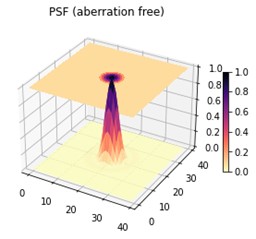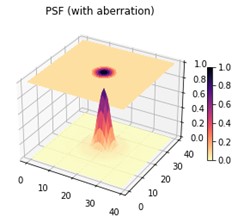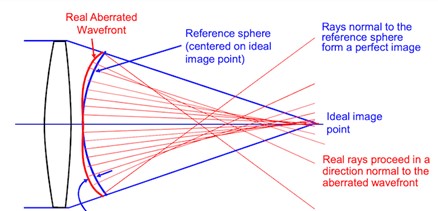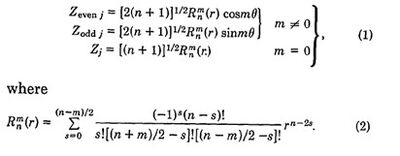Wavefront Retrieval from Through-Focus Point Spread Functions with Machine Learning: Difference between revisions
No edit summary |
|||
| Line 26: | Line 26: | ||
In this project, we use the first 36 Zernike polynomials only. | In this project, we use the first 36 Zernike polynomials only. | ||
The Taylor series of a [[real-valued function|real]] or [[complex-valued function]] {{math|''f'' (''x'')}} that is [[infinitely differentiable function|infinitely differentiable]] at a [[real number|real]] or [[complex number]] {{math|''a''}} is the [[power series]] | |||
<!-- | |||
Any changes to the following formula, without first obtaining consensus on the discussion page will be reverted. In particular, *DO NOT* add f(x)= here. | |||
-->:<math>f(a)+\frac {f'(a)}{1!} (x-a)+ \frac{f''(a)}{2!} (x-a)^2+\frac{f'''(a)}{3!}(x-a)^3+ \cdots, </math> | |||
where {{math|''n''!}} denotes the [[factorial]] of {{mvar|n}}. In the more compact [[Summation#Capital-sigma notation|sigma notation]], this can be written as | |||
<!-- | |||
Any changes to the following formula, without first obtaining consensus on the discussion page will be reverted. In particular, *DO NOT* add f(x)= here. | |||
-->:<math> \sum_{n=0} ^ {\infty} \frac {f^{(n)}(a)}{n!} (x-a)^{n}, </math> | |||
where {{math|''f''{{isup|(''n'')}}(''a'')}} denotes the {{mvar|n}}th [[derivative]] of {{mvar|f}} evaluated at the point {{mvar|a}}. (The derivative of order zero of {{mvar|f}} is defined to be {{mvar|f}} itself and {{math|(''x'' − ''a'')<sup>0</sup>}} and {{math|0!}} [[empty product|are both defined to be 1]].) | |||
With {{math|''a'' {{=}} 0}}, the Maclaurin series takes the form:<ref>{{harvnb|Thomas|Finney|1996|loc=§8.9}}</ref> | |||
:<math>f(0)+\frac {f'(0)}{1!} x+ \frac{f''(0)}{2!} x^2+\frac{f'''(0)}{3!}x^3+ \cdots, </math> | |||
or in the compact sigma notation: | |||
:<math> \sum_{n=0} ^ {\infty} \frac {f^{(n)}(0)}{n!} x^{n}.</math> | |||
== Methods == | == Methods == | ||
Revision as of 22:09, 8 December 2023
Introduction
This project is about estimating wavefront error based on point spread function at different focus locations (at and around focus along optical path). Point spread function can be calculated from wavefront error, but there is no theoretical method to calculate wavefront error from point spread function. This is because the transformation from wavefront error to point spread function is not one-to-one. We overcome this challenge by using machine learning. First, we generated multiple samples of random wavefront error. Second, we calculated the point spread function at a range of focus locations based on each sample of wavefront error. Third, we used regression to relate the wavefront error to point spread function at different focus locations. Lastly, we compared the wavefront error estimated by our regression model to the real wave front error.
Background
Point Spread Function
Point spread function can represent optical quality. It is a measure of intensity (or relative intensity) as a function of x and y location (where optical path is along z-axis). Ideally, when a beam pass through a convex lens, the point spread function at focus location should be sharp, where the peak is the location that the beam focuses on.
However, with error such as aberration, the point spread function will be flatter.
Wavefront Error
Wavefront error is the difference between the reference wavefront phase and the detected wavefront phase of an optical system.
In simulation, we model the wavefront error using Zernike polynomials. Each Zernike polynomial represents the wavefront deviation in shape, and it is orthogonal to other Zernike polynomials. The overall wavefront error can be represented by the sum of a constant multiplying each Zernike polynomial.
Failed to parse (syntax error): {\displaystyle ϕ(u,v)= ∑_1^N c_i Z_i (u,v) } (Zi is a Zernike polynomial)
In this project, we use the first 36 Zernike polynomials only.
The Taylor series of a real or complex-valued function Template:Math that is infinitely differentiable at a real or complex number Template:Math is the power series
where Template:Math denotes the factorial of Template:Mvar. In the more compact sigma notation, this can be written as
where Template:Math denotes the Template:Mvarth derivative of Template:Mvar evaluated at the point Template:Mvar. (The derivative of order zero of Template:Mvar is defined to be Template:Mvar itself and Template:Math and Template:Math are both defined to be 1.)
With Template:Math, the Maclaurin series takes the form:<ref>Template:Harvnb</ref>
or in the compact sigma notation:








